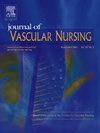Managing anxiety in men undergoing surveillance in the NHS abdominal aortic aneurysm screening programme: A survey of screening staff in England
IF 1.1
Q3 NURSING
引用次数: 0
Abstract
Background
AAA is an enlargement in the aorta that can increase in size and rupture. In England, the National Health Service (NHS) AAA Screening Programme offers screening to all men aged 65 to identify those with an AAA. Men with small or medium sized aneurysm enter surveillance where they receive ultrasound scans annually or every three months respectively. Due to concerns about mortality from AAA rupture, anxiety levels may be high for men and their families and impact on their quality of life.
Aim
To obtain the views of staff providing Abdominal Aortic Aneurysm (AAA) screening on how best to help men in surveillance to manage AAA-related anxiety.
Methods
A cross-sectional online survey of the 38 AAA regional screening services in England was conducted. Four staff with different roles from each service (doctor, nurse, manager and scanning technician) were asked to complete an online questionnaire.
Results
The response rate was 71 % (27/38) for regional AAA screening services and 65 % (99/152) for the staff approached. 93 % (79/84) of respondents strongly or somewhat agreed that men in surveillance may need help to manage anxiety. The size of the aneurysm was rated as the factor most likely to cause anxiety. 63 % (51/81) considered AAA Programme Nurses to be the best people to deliver an intervention. Staff suggested that improved information about AAA and associated risks, group support/networking sessions, and more contact with the screening service were ways of helping with management of anxiety.
Conclusion
Staff providing AAA screening recognised that being in surveillance can cause anxiety for men and their families, and identified that potential interventions, such as organised support groups and improved provision of information, might help manage anxiety. Programme Nurses were considered the ideal healthcare professional to help men in surveillance manage AAA-related anxiety.
在NHS腹主动脉瘤筛查项目中接受监测的男性的焦虑管理:一项对英格兰筛查人员的调查
背景:aaa是主动脉肿大,可增大并破裂。在英国,国民健康服务(NHS)的AAA筛查项目为所有65岁以上的男性提供AAA筛查,以确定那些患有AAA的男性。患有小型或中型动脉瘤的男性进入监测,他们分别接受每年或每三个月的超声扫描。由于担心AAA破裂的死亡率,男性及其家人的焦虑水平可能很高,并影响他们的生活质量。目的了解腹主动脉瘤(AAA)筛查工作人员对如何最好地帮助监测中的男性管理AAA相关焦虑的看法。方法对英国38家AAA区域性筛查机构进行横断面在线调查。每个服务部门的四名不同角色的工作人员(医生、护士、经理和扫描技术员)被要求完成一份在线问卷。结果对地区AAA筛查服务的应答率为71%(27/38),对工作人员的应答率为65%(99/152)。93%(79/84)的受访者强烈或多少同意接受监测的男性可能需要帮助来控制焦虑。动脉瘤的大小被认为是最可能引起焦虑的因素。63%(51/81)认为AAA项目护士是提供干预的最佳人选。工作人员建议,改善有关AAA和相关风险的信息,团体支持/网络会议,以及更多地接触筛查服务是帮助管理焦虑的方法。结论:提供AAA筛查的工作人员认识到,接受监测可能会导致男性及其家人焦虑,并确定可能的干预措施,如组织支持小组和改进信息提供,可能有助于控制焦虑。项目护士被认为是理想的医疗保健专业人员,以帮助男性监测管理aaa相关的焦虑。
本文章由计算机程序翻译,如有差异,请以英文原文为准。
求助全文
约1分钟内获得全文
求助全文
来源期刊

Journal of Vascular Nursing
NURSING-
CiteScore
1.40
自引率
0.00%
发文量
33
期刊介绍:
Journal of Vascular Nursing provides clinical information regarding aortic and peripheral aneurysms, upper and lower extremity arterial disease, acute and chronic venous disease, and more. Original, peer-reviewed articles present descriptions, etiologies, diagnostic procedures, medical and surgical treatment and nursing implications of vascular system disorders.
 求助内容:
求助内容: 应助结果提醒方式:
应助结果提醒方式:


